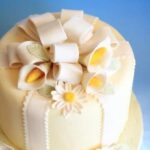Fondant has become a popular choice for decorating wedding cakes due to its versatility and ability to create stunning, flawless finishes. In this article, we will explore the beauty of fondant as a cake decorating medium and provide you with expert tips and techniques for creating a beautiful fondant wedding cake.
When it comes to creating a show-stopping wedding cake, choosing the right fondant is crucial. We will discuss how to select the best fondant for your cake and provide you with valuable insights on how to work with it seamlessly. From preparing the cake to adding the finishing touches, we will guide you through each step of the process, ensuring that you achieve professional-looking results.
Whether you are a novice or experienced baker, this comprehensive guide will equip you with the knowledge and skills needed to elevate your wedding cake creations. Join us as we delve into the world of fondant wedding cakes and unlock the secrets to turning your vision into a stunning, edible masterpiece.
Choosing the Right Fondant
When it comes to decorating a fondant wedding cake, choosing the right fondant is crucial. There are different types of fondant available in the market, including rolled fondant, poured fondant, and marshmallow fondant. Rolled fondant is the most commonly used type for wedding cakes due to its ease of use and smooth finish.
When selecting a rolled fondant for your wedding cake, consider factors such as taste, texture, and workability. It’s important to choose a fondant that not only looks great but also tastes delicious.
Once you have selected the right type of fondant for your wedding cake, it’s essential to know how to work with it properly. Working with fondant requires some skill and practice, but with the right techniques, you can achieve professional-looking results. Before applying the fondant to your cake, make sure to knead it well to soften it and improve its pliability. Roll the fondant out on a clean surface dusted with powdered sugar or cornstarch to prevent sticking.
It’s also important to ensure that your cake is properly prepared before applying the fondant. The surface should be smooth and free of any crumbs or imperfections. A layer of buttercream icing can help create a smooth canvas for the fondant.
Using a pastry brush or smoothing tool can help ensure that there are no air bubbles or wrinkles when applying the fondant. By following these tips for selecting and working with the right fondant for your wedding cake, you can create a stunning centerpiece for your special day.
| Choosing Fondants | Working With Fondants |
|---|---|
| Consider taste, texture, workability | Knead well before rolling out |
| Choose rolled fondants for smooth finish | Use powdered sugar or cornstarch when rolling out |
| Ensure cake surface is smooth before application | Use pastry brush or smoothing tool |
Preparing the Cake
Before you can begin decorating a fondant wedding cake, it’s essential to properly prep the cake to ensure a smooth and flawless finish. The first step in preparing the cake is to ensure that it is completely cooled before applying any icing or fondant. Warm cakes can cause the icing to melt, resulting in an uneven surface.
After your cake has cooled, it’s time to apply a layer of buttercream or ganache as a base coat. This not only adds flavor but also helps the fondant adhere to the cake. Use a palette knife to spread a thin layer of icing over the entire cake, making sure to fill in any gaps or uneven areas.
Once your cake is iced, it’s important to smooth the surface as much as possible. You can use a bench scraper or offset spatula to achieve a smooth finish on the sides and top of the cake. Taking your time with this step will ensure that your fondant has a perfect foundation for decorating.
Properly prepping your cake is crucial for achieving professional-looking results when decorating with fondant. By following these steps, you’ll create a flawless canvas for applying and designing your beautiful fondant wedding cake.
| Prepping Tips | Details |
|---|---|
| Cooling the Cake | Make sure the cake is completely cooled before applying icing or fondant. |
| Base Coat Application | Use buttercream or ganache as a base coat and spread it evenly over the entire cake. |
| Smoothing Techniques | Employ tools like bench scrapers or offset spatulas to achieve a smooth surface for fondant application. |
Creating a Smooth Canvas
When it comes to decorating a fondant wedding cake, achieving a smooth canvas is essential for creating a flawless and seamless finish. Here are some techniques for rolling out and applying fondant to ensure that your wedding cake looks professional and visually appealing:
1. Prepare the surface: Before rolling out the fondant, make sure that the surface of the cake is properly prepared. This includes icing the cake with a thin layer of buttercream or ganache to create a smooth base for the fondant.
2. Roll out the fondant: Dust your work surface with powdered sugar or cornstarch to prevent sticking, then roll out the fondant to an even thickness using a rolling pin. Aim for a thickness of about 1/8 inch, ensuring that it is large enough to cover the entire cake.
3. Lift and drape: Carefully lift the rolled-out fondant using a rolling pin or your hands and drape it over the cake. Work quickly but gently to avoid creases or tears in the fondant.
4. Smooth and trim: Use a fondant smoother or your hands to gently smooth the fondant onto the cake, starting from the top and working your way down to eliminate any air bubbles or wrinkles. Trim off any excess fondant at the base of the cake using a sharp knife.
By following these techniques for rolling out and applying fondant, you can achieve a flawless and seamless finish on your wedding cake, providing the perfect canvas for adding intricate designs and decorations.
Adding Texture and Detail
When it comes to decorating a fondant wedding cake, adding texture and intricate designs can take your creation to the next level. Here are some tips for incorporating stunning details onto the fondant surface:
1. Embossing: One way to add texture to your fondant wedding cake is by using embossing tools or mats. These tools can create beautiful patterns and designs that give the cake a sophisticated look. Simply roll the embossing tool over the fondant to create an even, textured surface.
2. Piping: Another way to add detail to your fondant cake is by using piping techniques with royal icing or buttercream. You can pipe delicate lace designs, intricate borders, or even write personalized messages on the cake.
3. Appliqués and Cutouts: Consider using fondant cutters or silicone molds to create 3D appliqués and cutouts that can be attached to the cake’s surface. These pieces can add depth and dimension to your design, making your wedding cake truly stand out.
Using these techniques will allow you to create a visually striking wedding cake that will leave a lasting impression on your guests. From embossed patterns to delicate piping, there are endless possibilities for adding texture and detail onto your fondant wedding cake.
Whether you’re going for a classic, elegant look or a more whimsical design, these methods will help you achieve professional-looking results and create a memorable centerpiece for your special day.
Color and Fondant
Color plays a crucial role in the overall aesthetic of a wedding cake, and when it comes to fondant, there are various methods for achieving the perfect hues and tones. Whether you are aiming for pastel shades, vibrant colors, or metallic finishes, understanding how to color fondant effectively is essential for creating a cohesive and visually appealing color scheme for your wedding cake.
Coloring Fondant
There are several ways to add color to fondant, including using gel or paste food coloring, powdered food coloring, or even natural ingredients such as fruit purees or extracts. Gel or paste food coloring is often preferred due to its concentrated formula, which allows for more intense colors without altering the consistency of the fondant. When adding color, it’s important to knead the fondant thoroughly to ensure even distribution and avoid streaks or patches.
Creating a Cohesive Color Scheme
When planning the color scheme for a fondant wedding cake, it’s essential to consider the overall theme of the event, as well as any specific color preferences from the couple. Some popular approaches include using a monochromatic palette with varying shades of a single color, incorporating complementary colors for contrast and visual interest, or opting for an ombre effect that transitions seamlessly from one hue to another.
By carefully selecting and blending colors, it’s possible to achieve a harmonious and visually striking result that enhances the overall design of the cake.
Incorporating Metallic Finishes
For couples looking to add a touch of luxury and glamour to their wedding cake, metallic finishes can be achieved by either using pre-colored metallic fondant or dusting edible luster dust onto tinted fondant. Whether it’s gold, silver, copper, or rose gold, metallic accents can elevate the elegance of a fondant wedding cake and create stunning visual impact.
It’s important to work with metallic finishes sparingly and strategically to avoid overpowering the design while still adding a touch of brilliance and sophistication.
Edible Decorations
Creating edible decorations with fondant is a delightful way to customize your wedding cake and add a personal touch. Whether it’s delicate flowers, intricate figurines, or other decorative elements, fondant provides a versatile medium for crafting beautiful and edible adornments. In this section, we’ll explore how to use fondant to create these edible decorations that will elevate the overall look of your wedding cake.
Choosing the Right Fondant for Edible Decorations
When it comes to crafting edible decorations with fondant, it’s essential to select the right type of fondant. Look for a high-quality, pliable fondant that can be easily shaped and molded without cracking or drying out. It’s also important to consider the taste and texture of the fondant, as these decorations will be consumed along with the cake. Opt for a fondant that is both visually appealing and pleasant to eat.
Crafting Edible Flowers and Figurines
One of the most popular uses of fondant in wedding cake decoration is creating edible flowers and figurines. With the right tools and techniques, you can mold fondant into lifelike petals, leaves, and blooms to adorn your cake. Similarly, figurines such as bride and groom toppers or whimsical characters can be crafted from fondant with precision and attention to detail. By using food-safe coloring agents, you can also achieve a wide range of colors for your handmade decorations.
Other Decorative Elements
In addition to flowers and figurines, there are numerous other decorative elements that can be crafted from fondant for your wedding cake. From delicate lace patterns and intricate borders to personalized monograms or thematic motifs, the possibilities are endless when it comes to using fondant for creating custom embellishments. With patience, practice, and creativity, you can elevate your wedding cake design with unique and personalized decorative elements crafted from fondant.
Now that we’ve explored how to use fondant to craft edible flowers, figurines, and other decorative elements for your wedding cake, you’ll be well-equipped to add an extra layer of artistry and personalization to this centerpiece of your special day.
Troubleshooting and Tips
Decorating a fondant wedding cake can be a beautiful and creative process, but it also comes with its own set of challenges. From ensuring a smooth finish to dealing with color issues, here are some common challenges that you might encounter when working with fondant, along with expert advice for overcoming them.
One of the most common challenges when decorating with fondant is achieving a smooth and flawless finish. To address this issue, it’s important to properly prepare the cake before applying the fondant. Make sure the cake is level and has been covered with a thin layer of buttercream or ganache to create a smooth surface.
Additionally, using a fondant smoother and gentle hand movements can help to eliminate air bubbles and creases in the fondant. If you still encounter bumps or imperfections, don’t be afraid to carefully lift and smooth out the fondant again.
Another challenge that may arise when working with fondant is coloring. It’s crucial to use gel-based food coloring rather than liquid ones to prevent altering the texture of the fondant. Start by adding a small amount of color at first and gradually build up to achieve the desired hue. Additionally, if you need multiple tiers of fondant in the same color, make sure to accurately measure and mix enough colored fondant for each tier before rolling it out.
Furthermore, creating intricate designs and patterns on the fondant can be challenging as well. To ensure precision, consider using stencils, embossing tools, or even silicon molds for consistent results. In addition, practice piping delicate details with royal icing or using edible markers for fine lines. Taking your time and being patient will ultimately result in professional-looking embellishments on your wedding cake.
Finishing Touches
In conclusion, decorating a fondant wedding cake is a beautiful and intricate process that requires attention to detail and patience. From choosing the right fondant to adding the final finishing touches, every step plays a crucial role in creating a stunning and memorable centerpiece for your special day.
One of the most important aspects of decorating a fondant wedding cake is selecting the right fondant for your needs. Whether you choose to make your own or purchase pre-made fondant, ensuring that it has the right consistency and taste is essential for a successful outcome. Additionally, learning how to work with fondant and properly prep the cake before applying it will help you achieve a smooth canvas for your decorative details.
Once the fondant is applied, adding texture, detail, and color to the cake will elevate its visual appeal. Whether you opt for intricate designs or simple yet elegant embellishments, these elements will contribute to the overall aesthetic of the cake. Finally, putting the finishing touches on your fondant wedding cake by adding borders, ribbons, and other decorative details will provide a polished and cohesive look that ties everything together seamlessly.
In essence, mastering how to decorate a fondant wedding cake takes practice and dedication but with proper guidance and techniques like those outlined in this article, you can create a stunning masterpiece that will impress your guests and leave a lasting impression on your special day.
Frequently Asked Questions
How Do You Put Decorations on a Fondant Cake?
Decorations can be placed on a fondant cake by using edible glue or water to adhere the fondant decorations. Roll out the fondant, cut out shapes with cookie cutters, and then place them on the cake.
How Do You Cover a Wedding Cake With Fondant Icing?
To cover a wedding cake with fondant icing, first, apply a thin layer of buttercream icing to the cake. Then, roll out the fondant into a large circle and carefully drape it over the cake. Smooth the fondant around the cake to prevent wrinkles.
How Do You Put Fondant on a Tiered Cake?
When putting fondant on a tiered cake, it’s important to cover each tier separately before stacking them together. Roll out the fondant for each tier and carefully drape it over, smoothing it down to create a seamless finish. Support each tier as you work to prevent any mishaps.

Welcome to my blog about home and family. This blog is a place where I will share my thoughts, ideas, and experiences related to these important topics. I am a stay-at-home mom with two young children. I hope you enjoy reading it! and may find some helpful tips and ideas that will make your home and family life even better!





